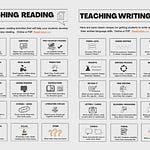ELT Pros Linkedin | Videos | Blog | Printables | ELT News | TpTs | YouTube
Instructional Modifications for Second Language Learners.
Many teachers will at some time have students in class for which English is their second language. When teaching these students, it's imperative that a teacher make small modification to their teaching to help these students both learn the content being taught and also the English necessary for classroom success.
Here are some of the main modifications teachers will make when teaching English language learners.
Get the free PDF Infographic here »> See this other related post »>
1. Vocabulary
Specialized vocabulary should be selected and pre-taught. Prepare your students in advance, even give them a handout of important vocabulary to master.
Students should keep a personal glossary/ notebook of definitions. This will help them track their learning and study the vocabulary.
Instruction should simplify the vocabulary and use synonyms of language the students are more familiar with.
2. Text and Images.
Use visuals and text supports - Realia, models, toys, banners, flipcharts, presentations, video, posters, drawings, graphic organizers, flash cards, vocabulary lists
Provide hands-on activities and demonstrate, just verbally explain.
Instructions.
Give clear instructions. Sequential and with visuals. Reinforce oral instructions and give clear guidelines
Allow students time for questions and to process instructions.
When possible always slowly model an activity rather than explain.
4. Note taking and Review
Highlight key terms and concepts.
Use a chart or post in class key concepts for constant review.
Provide notes and summaries for students to study and for reference.
Always check for student understanding.
5. Instructional Language.
Simplify language, avoid complex sentences or language.
Pause often and raise your voice to emphasize.
Avoid “teacher talk”, speak naturally but pause more.
Check for comprehension orally.
6. Non-verbal cues
Use body language, gestures, facial expressions, mime, to convey meaning.
Be aware that some “expression” may convey a negative meaning.
Provide concrete examples of concepts to students. Relate one thing to another
.
7. Time management.
Allow more time for student response. Students should prepare answers, brainstorm, in advance.
Give more time for projects, learning, completion of exercises.
8. Provide support.
Dictionaries, online materials for review, simple encyclopedias, leveled reading, out of class tutoring/help, internet reference, parental help
Give more time for student face to face help in non-class time.
Work closely with student language instructors.
9. Assessment and Testing.
Test for content knowledge NOT language ability.
Use more visuals, simplify the testing. Give tests orally for younger learners, lower levels.
Give more time to complete tests.
We hope these suggestions have been helpful! Try some of these in your teaching and slowly master them. It will make a big difference in your students’ learning outcomes.
See all our free professional development materials for member teachers - in our huge Lesson Library.













